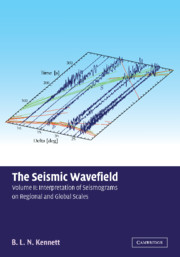Book contents
- Frontmatter
- Contents
- Preface to Volume II
- Part III Local and Regional Events
- Part IV Global Wave Propagation
- Part V The Three-dimensional Earth
- 30 The Influence of Heterogeneity
- 31 Imaging the Earth
- 32 3-D Global Structure
- 33 Mapping the Lithosphere and Upper Mantle
- Appendix Paths and Travel times
- Bibliography
- Index
33 - Mapping the Lithosphere and Upper Mantle
from Part V - The Three-dimensional Earth
Published online by Cambridge University Press: 31 August 2019
- Frontmatter
- Contents
- Preface to Volume II
- Part III Local and Regional Events
- Part IV Global Wave Propagation
- Part V The Three-dimensional Earth
- 30 The Influence of Heterogeneity
- 31 Imaging the Earth
- 32 3-D Global Structure
- 33 Mapping the Lithosphere and Upper Mantle
- Appendix Paths and Travel times
- Bibliography
- Index
Summary
When we come to study a specific region of the Earth we can exploit both seismic events within and surrounding the region, and those at teleseismic distances, by looking at different aspects of the wavefield.
Where waveform inversion is used for fundamental and higher mode surface waves, the results of global studies of the mantle can provide a useful starting point for the characteristics of large-scale heterogeneity. Particularly where temporary stations have been deployed to enhance coverage it is possible in a regional survey to obtain much higher horizontal resolution as has been demonstrated, e.g., by the Skippy experiment in Australia (van der Hilst, Kennett & Shibutani, 1998).
For body wave studies, we can use the waves refracted back from the upper mantle within the region if we can disentangle the triplications induced by the presence of the mantle discontinuities. Such regional arrivals travel at shallow angles through the structure. We can also use the arrivals from distant events for which the ray paths travel relatively steeply through the upper part of the mantle and so provide a different class of information. Where we have local seismicity, we can also exploit the observations of these events at distant stations with a knowledge of the global 3-D structure outside the region of interest.
Regional surface-wave tomography
In order to obtain high resolution images of the shallower part of the Earth we need to use seismological probes whose sensitivity is greatest in this region. Fortunately we are able to exploit the surface wave portion of the shear wavefield which commonly represents the largest amplitude portion of broad-band seismograms.
The fundamental mode Love waves and Rayleigh waves are preceded by higher mode surface waves which represent the superposition of multiply reflected S waves interacting with the free surface (cf. § I:16.2). The fundamental mode energy is concentrated near the surface, but the penetration increases as the frequency is reduced because the S wavelength is longer. The higher modes provide both deeper penetration at comparable frequency and complementary information on shallow structure because the pattern of sampling is rather different.
The influence of Earth structure on the surface waves appears through the frequency dispersion of the different surface wave modes so that the character and frequency content changes along the wavetrain as it is recorded at an individual station.
- Type
- Chapter
- Information
- The Seismic WavefieldVolume II: Interpretation of Seismograms on Regional and Global Scales, pp. 461 - 487Publisher: Cambridge University PressPrint publication year: 2002
- 1
- Cited by



